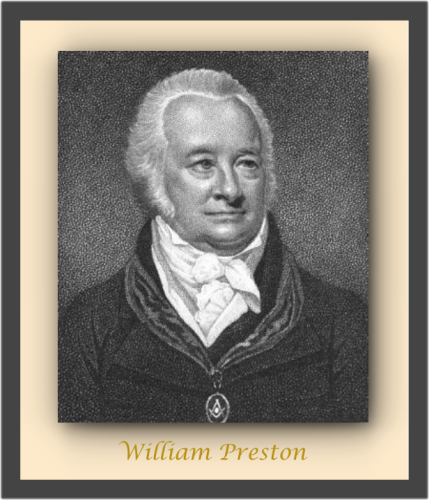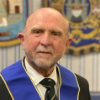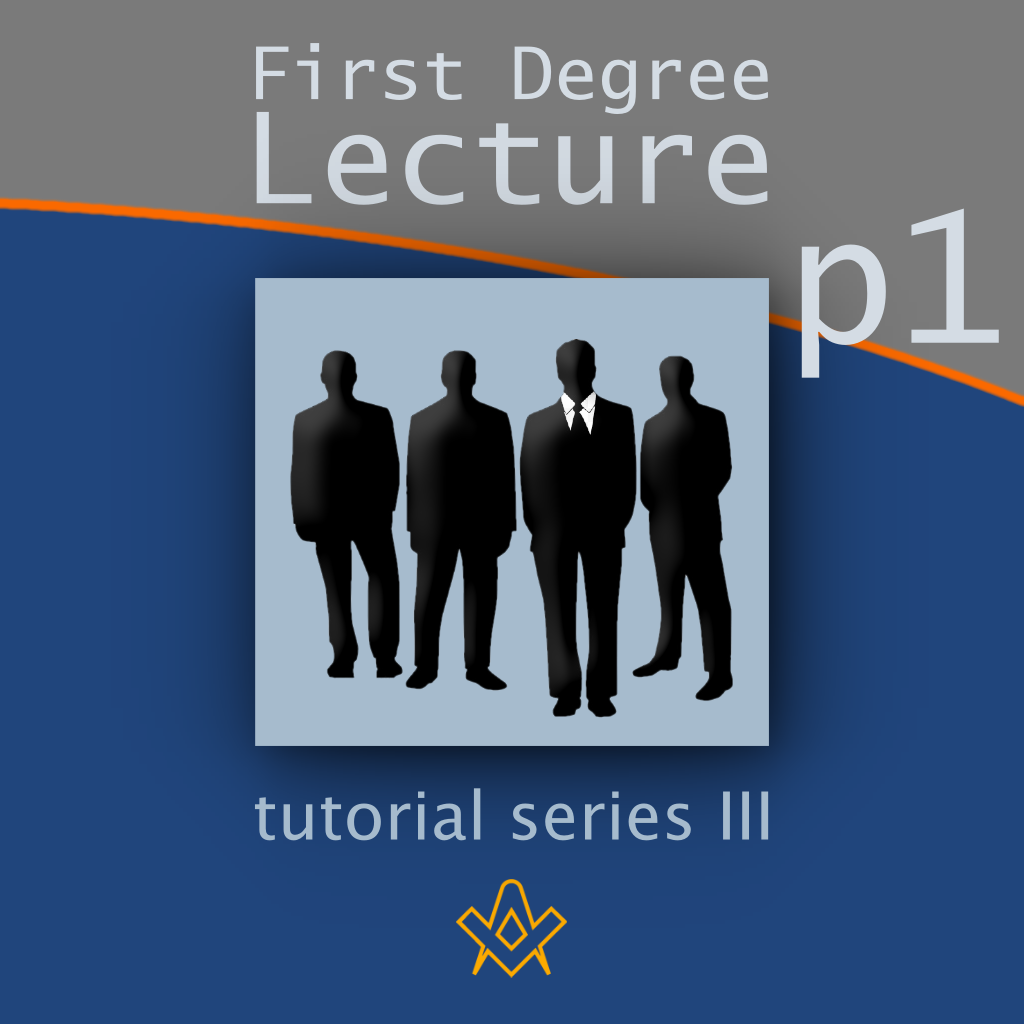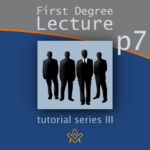Mentor’s Notes – Learning Outcomes
By the end of this tutorial the learner will be able to:
• Explain the difference between West and East in Masonic terms.
• Explain Signs, Tokens and Points of Entrance.
• Explain Just, Perfect and Regular.
• Explain the meaning of the Key.
• Reflect upon Section One of the First Degree Lecture.
“If it ain’t broke don’t fix it.”
A phrase I often hear when changes are being made.
In Masonic learning is this the case?
William Preston (1742 – 1818) gives his lecture in the form of a Catechism – questions and answers – and broken down into seven bite size chunks.
Is this 18th century method a good way of learning? I leave it to you, the student, to answer that question as each of us have our own style of learning.
I hope that the written word along with a voice over and some visual content caters for your learning needs.
In this series of Tutorials, I will be examining each of the seven sections of Preston’s First Degree Lecture.
Section One Preston explains the process of testing a stranger who purports to be a Freemason and is what we are going to examine in this session.
In Section Two he goes through the examination of a stranger who is not a Freemason entering the Lodge on his Initiation.
Section Three Preston examines what an Entered Apprentice has to learn, that of being a “Moral Man”.
Section Four investigates the form of a Freemason’s Lodge. A parallelepipedon.
Section Five he takes us inside the Lodge to examine the furniture, ornaments and jewels.
In Section Six he describes the virtues required of a Freemason and the foundations of Freemasonry.
Finally, in Section Seven the responsibilities of a Lewis and the distinguishing characteristics of a Freemason are explained.
Below is the First Section of the First Degree Lecture as written by William Preston along with a very few notes that I have made.
I hope you enjoy what Preston has to say.
Stephen J. Goulding PPGJD, SLGCR.
Introductory Address by William Preston

BRETHREN, Masonry; according to the general acceptation of the term, is an Art founded on the principles of Geometry, and directed to the service and convenience of mankind.
But Freemasonry embracing a wider range, and having a more noble object in view namely the cultivation and improvement of the human mind, may, with more propriety, to be called a Science, although its lessons for the most part are veiled in Allegory and illustrated by Symbols, in as much as, veiling itself under the terms of the former, it inculcates principles of the purest morality.
To draw aside this veil therefore, or, more properly speaking, to penetrate through its mysteries, is the object of our Masonic Lectures, and by a faithful and appropriate attention to them we hope ultimately to become acquainted with all its mysteries.
The Lecture of this Degree is divided into seven Sections, and throughout the whole, virtue is depicted in its most beautiful of colours, the duties of morality are everywhere strictly enforced.
The nature, character, the attributes and perfections of the Deity are faithfully delineated and forcibly portrayed, and are well calculated to influence our conduct towards Him, as our Father, Benefactor, and Moral Governor, as also in the proper discharge of the duties of social life.
(NOTE: This introduction is proof of what a great “wordsmith” William Preston is. It incapsulates Freemasonry, and in my opinion, draws the reader in leaving him wanting more.
Examples :-
Freemasonry “the cultivation and improvement of the human mind”.
“Virtue depicted in its most beautiful of colours.”
“The nature, character, the attributes and perfections of the Deity are faithfully delineated and forcibly portrayed.”)
Let us proceed to the Lecture.
The First Degree Lecture, Section one, by William Preston.
Video Presentation
The mode of Masonic instruction is the catechetical, or, in a more familiar terms, by question and answer; therefore, from a previous conviction that you are a Mason, permit me to ask you in that character:
Q. As Free and Accepted Masons, how did you and I first meet?
A. On the Square.
Q. How do we hope to part?
A. On the Level.
Q. Why meet and part in that particular manner?
A. As Masons we should so act on the Square, as to enable us to part on the Level with all mankind, particularly a Brother.
(NOTE: “The square represents fairness, balance, and firmness. Something that is squared is something that is stable, a foundation for building upon.”
The Level reminds us that to so high an eminence may we rise in our lives in the eyes of the Almighty we stand as equals.
Our more modern take is a reverse of that phrase, “We meet upon the Level and part upon the square”, the sentiment, however, is the same.)
Q. As Masons whence come you?
A. The West.
Q. Whither directing your course?
A. The East.
Q. What inducement have you to leave the West and go to the East?
A. To seek a Master, and from him to gain instruction.
(NOTE: The West represents darkness where the sun goes down. The East represents light, where the sun rises. The Mason is therefore seeking the light of knowledge from a Master of the Craft where the sun rises in order to have a full day of learning.)
Q. Who are you that want instruction?
A. A Free and Accepted Mason.
Q. What manner of man ought to be a Free and Accepted Mason?
A. A free man, born of a free woman, brother to a King, fellow to a Prince or to a beggar, if a Mason, and found worthy.
Q. Why freeborn?
A. In allusion to that grand festival which Abraham made at the weaning of his son Isaac, when Sarah, Abraham’s wife, observing Ishmael, the son of Hagar the Egyptian bondwoman, teasing and perplexing her son, remonstrated with her husband, and said: “Put away that bondwoman and her son, for such as he shall not inherit with the freeborn, even with my son Isaac.” She spake as being endued with a prophetic spirit , well knowing that from Isaac’s loins would spring a great and mighty people, who would serve the Lord with freedom, fervency and zeal; and fearing that if the two youths were brought up together, Isaac might imbibe some of Ishmael’s slavish principles; it being a general remark in those days, as well as the present, that the minds of slaves are more vitiated (meaning – spoil or impair the quality ) and less enlightened than those of the freeborn; but in the present day, slavery being generally abolished, it has therefore been considered under Constitution, that if a man be free, although he may not have been freeborn, he is eligible to be made a Mason.
(NOTE: This passage is a quote from Geneses 21:8. Quite a stereotypical piece of work but a reflection of the attitude of that period of history. Like all history, it cannot be changed but can be learned from. The message is that Masons should be aware with whom they mix, not by social or intellectual standing but by virtuous behaviour. “Brother to a King, fellow to a Prince or to a beggar.”)
Q. Why those qualities among Masons?
A. We are all created equal, which is strengthened by our Masonic Oath.
Q. Generally speaking, as a Mason whence come you?
A. From a worthy and worshipful Lodge of Brothers and Fellows to greet your Worship well.
Q. Any other recommendations?
A. Hearty good wishes.
Q. Since you bring nothing but hearty good wishes, what do you come here to do?
A. To learn to rule and subdue my passions, and make further progress in Masonry.
Q. By this I presume you are a Mason?
A. I am so taken and accepted among Brothers and Fellows.
(NOTE: As a Mason seeking knowledge it is by visiting other lodges and seeing the work of other Masters that the Mason receives a better understanding of Freemasonry. Comparing and contrasting the work.
“What you see praiseworthy in others you should carefully imitate, what in them you find defective in yourself you should amend.” [Address to the Wardens]
We are now entering that phase where a Mason is proving himself to be such before being admitted into a lodge or partake in Masonic mysteries.)
Q. How do you know yourself to be a Mason?
A. By the regularity of my Initiation, repeated trials and approbations, and a willingness at all times undergo examination when properly called on.
Q. How do you demonstrate the proof of you being a Mason to others?
A. By Signs, Tokens, and the Perfect Points of my entrance.
Q. What are Signs?
A. All Squares, Levels, Perpendiculars are true and proper signs to know a Mason by.
Q. What are Tokens?
A. Certain regular and friendly Grips, whereby we know a Brother in the dark as well as in the light.
Q. Will you give me the Points of your Entrance?
A. Give me the first, I will give you the second.
(NOTE: The lesson here is to be cautious with strangers so that we do not admit Cowans and intruders to our assemblies.)
Q. What do you wish to Collect?
A. Of, At and On.
Q. Of, At and On what?
A. Of my own free will and accord; At the door of the Lodge; On the Point of a Square presented to my naked left breast
(NOTE: Preston states “on the point of a square”, which in the more modern UGLE ritual represents the second degree. We also know that in the ritual of the seventeenth century a trowel was used at this point in a ceremony. Has he made a mistake or was the ritual of the eighteenth century, and pre the Union in 1813, just so for either the Moderns or the Antients? We also know that immediately after the Union of the two Grand Lodges, the sword was used by the Inner Guard but it quickly changed to the poniard as the sword inside a Lodge room was deemed un-Masonic.)
Q. When were you made a Mason?
A. When the sun was at its meridian.
Q. In this country Freemason’s Lodges are usually held in the evening: how do you account for that, which at first view appears a paradox?
A. The earth constantly revolving on its axis in its orbit around the sun, and Freemasonry being universally spread over its surface, it necessary follows that the sun must always be at its meridian with respect to Freemasonry.
(NOTE: This is explaining that Freemasonry is universal. Whatever continent you visit you will find a Freemason’s lodge. Lodge meetings have been held in the trenches of WWI, in WWII Prisoner of War camps, on board ships, and anywhere a group of seven or more Freemasons congregate for the purpose of Freemasonry.)
Q. What is Freemasonry?
A. A peculiar system of morality, veiled in allegory, and illustrated by symbols.
Q. Where were you made a Mason?
A. In the body of the Lodge, just, perfect and regular.
Q. What is a Lodge of Freemasons?
A. An assemblage of Brethren, met to expatiate on the mysteries of the Craft.
(NOTE: “Expatiate” meaning to speak or write about something in great detail or for a long time. It is in our lodges that we are taught that “peculiar system of morality”.)
Q. When met, what makes it just?
A. The Volume of the Sacred Law unfolded.
(NOTE: The VSL must always be open in a regular Lodge when the Lodge is at labour. It is the Volume of the Sacred Law that is the Freemason’s guide and should be placed in such a position that the Worshipful Master can read from it. )
Q. What perfect?
A. Seven, or more, regularly made Masons.
NOTE: Three rule a lodge – Master and two Wardens. Five hold a lodge – add two Fellowcrafts. Seven or more make a perfect lodge – add a further two Entered Apprentices. Take your mind back to the guilds and a Master Craftsman forming his own working group.)
Q. And what regular?
A. The Charter or Warrant of Constitution.
NOTE: The Charter or Warrant of Constitution is issued and owned by the Grand Master and gives the authority to the lodge to act in such a capacity. Should a lodge dissolve then the Warrant or Charter must be returned to the Grand Master. As a point of interest read about the “Travelling Warrants” of the military.)
Q. Why were you made a Mason?
A. For the sake of obtaining the Secrets of Masonry, and be brought from darkness.
Q. Have Mason’s Secrets?
A. They have many invaluable ones.
Q. Where do they keep them?
A. In their Hearts.
Q. To whom do they reveal them?
A. None but Brothers and Freemasons.
Q. How do they reveal them?
A. By Signs, Tokens, and particular Words.
Q. As Masons, how do we hope to get them?
A. By the help of a key.
Q. Does the key hang or lie?
A. It hangs.
Q. Why is the preference given to hanging?
A. It should always hang in a Brother’s defence, and never to lie to his prejudice.
Q. What does it hang by?
A. The thread of life, in the passage of utterance
Q. Why is it so nearly connected to the heart?
A. Being an index of the mind, it should utter nothing but what the heart truly dictates.
Q. It is a curious key, of what metal is it composed?
A. No metal, it is the tongue of good report.
(NOTE: The motto of the United Grand Lodge of England; “Audi, Vide, Tace” – Meaning “hear, see, be silent”.)
Brethren this ends the first section of the first lecture.
That excellent key, a Freemason’s tongue, which should speak well of a Brother absent or present, but if unfortunately that cannot be done with honour and propriety, one should adopt that excellent virtue of the Craft, which is Silence.
(NOTE: This First Section is about the meeting of a stranger who is a Brother, testing him to prove his status in order to allow him into a lodge.
In Section Two we will be examining a stranger who is not a Freemason entering the lodge on his Initiation.
My first words were “If it ain’t broke don’t fix it”, relating to Masonic learning. I hope you have both learnt from and enjoyed Preston’s style of teaching. But don’t close your mind to other forms of learning as I have seen some amazing teaching methods, the Metaverse being one of many. Enjoy your journey through Masonic learning and make a daily advancement in Masonic knowledge.)
Bibliography
First Degree Lecture (Section One), William Preston.

Book Intro – Illustrations of Masonry
Introduction to Illustrations Of Masonry by William Preston (1742-1818)
more….
Article by: Stephen J. Goulding

Stephen was initiated into Freemasonry in 1978 in Tylney Lodge No. 5856 (UGLE). He was Master in 1989 & 2004.
He was Master of the Lodge of Union 38 (UGLE) in 2018. He is also a PZ in the Holy Royal Arch and PM in the Mark Degree.
Stephen served 30 years in the Metropolitan Police Service (London, England) before going into education in 2000, where he became a college lecturer and a mentor for both the college and the University of Greenwich (London, England). Now retired, he teaches Tai Chi and Qigong in the community.
Facebook: Steve Goulding-Tai Chi West Sussex–Chi at Chi
Recent Articles: The First Degree Lecture
masonic knowledge
to be a better citizen of the world
share the square with two brothers

click image to open email app on mobile device














